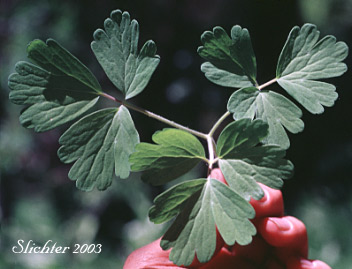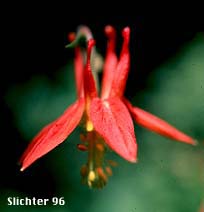 The photo at
right shows a close-up of a leaf of red columbine as seen at Blue Sky, Hart Mt.
National Antelope Refuge........June 25, 2003.
The photo at
right shows a close-up of a leaf of red columbine as seen at Blue Sky, Hart Mt.
National Antelope Refuge........June 25, 2003.
Red columbine is one of the more distinctive and attractive wildflowers to be viewed in the Pacific Northwest. Several erect stems arise from 15-100 cm high. The stems are largely leafless, although an occasional reduced leaf may be found on the stem.
The basal leaves are divided into multiples of three leaflets. These smaller leaflets are further lobed. Any stem leaves that are present are alternate and smaller representatives of the basal leaves. The upper leaf surfaces are glaucous (bluish-green) while the undersides are typically pubescent.
The flowers are irregularly shaped, with five red sepals flared to the sides, and five smaller yellow petals extending below the petals. The blade of the petal (below the sepals) measures approximtely 2-5 mm long. The petals also consist of a long red, conical, nectar-producing spur which extends straight above the sepals. The stamens typically dangle below the petals. The whole flower tends to nod downward, with the spurs pointing upwards.
In the garden, red columbine is a long-lived perennial wildflower which reseeds fairly easily. It is an early spring bloomer, and may attract hummingbirds during their northerly spring migration.
Red columbine is found from moist, open forests of the lowlands, to subalpine meadows.
The red columbine is widely distributed throughout the Pacific Northwest, but in the arid regions, tends to be limited to near streams or mid to upper elevation meadows.
In the Columbia River Gorge it may be found between the elevations of 100'-4700' from Troutdale, OR east towards Mosier, OR.
